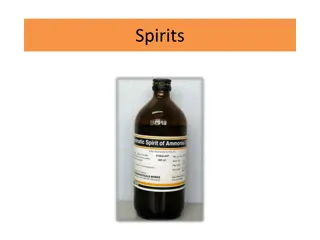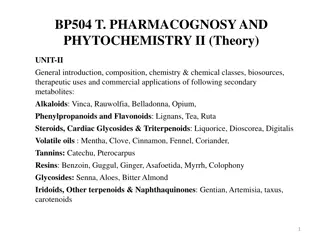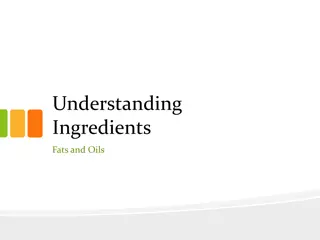Top Essential Oils in Delhi
In the bustling city of Delhi, amidst the chaos and stress, the quest for wellness and tranquillity becomes paramount. Essential oils, known for their therapeutic properties and aromatic allure, emerge as the go-to remedy for many seeking holistic healing. Among the myriad brands available, Wikka st
2 views • 3 slides
Understanding Spirits and Their Uses in Therapeutics and Flavoring
Spirits, also known as essences, are alcoholic or hydro-alcoholic solutions containing volatile substances. They can be classified based on therapeutic or flavoring purposes. These solutions are prepared by distillation or dissolving volatile substances in alcohol, with varying alcohol content. Spir
4 views • 17 slides
Get the Top-Quality Essential Oils in Australia in Wholesale
Explore the premium selection of wholesale essential oils in Australia Pastel Pines offers. \n\nOur diverse range of essential oils is expertly crafted to enhance your well-being and elevate the ambience of any space. \n\nAs a family-owned Australian business, we take pride in providing high-quality
0 views • 5 slides
Understanding Pharmaceutical Degradation: Types and Factors
Pharmaceutical degradation refers to the process of a formulation in a specific container losing its chemical, microbiological, therapeutic, physical, and toxicological specifications. It can be categorized into physical, chemical, and microbiological degradation. Physical degradation alters the dru
1 views • 50 slides
Understanding Spirits: Types and Uses
Spirits are alcoholic or hydro-alcoholic solutions of volatile principles, mainly volatile oils, classified into therapeutic and flavoring types. They are prepared by distillation or dissolving volatile substances in alcohol, with varying alcohol content. Proper storage in light-resistant containers
1 views • 20 slides
Volatile Oils in Pharmacognosy and Phytochemistry: Composition, Chemistry, Uses
Volatile oils, also known as essential oils, are derived from terpenes and their oxygenated compounds. These oils possess characteristic odors and are extracted from plants through various methods like hydro-distillation and steam distillation. They are commonly used as flavoring agents, perfumes, a
0 views • 29 slides
Understanding Memory Organization in Computers
The memory unit is crucial in any digital computer for storing programs and data. It comprises main memory, auxiliary memory, and cache memory, each serving different roles in data storage and retrieval. Main memory directly communicates with the CPU, while cache memory enhances processing speed by
1 views • 37 slides
Understanding Fuels and Their Sources
Fuels derived from petroleum, coal, shale oil, and tar sands are crucial for powering internal combustion engines. Crude oil contains various hydrocarbons requiring refining processes to obtain products like natural gas, gasoline, kerosene, diesel oils, fuel oils, and lubricating oils. The chemical
1 views • 7 slides
Understanding Secondary Metabolites of Rue (Ruta graveolens)
Rue (Ruta graveolens) is a herb known for its medicinal properties and aromatic leaves. It contains various chemical constituents such as flavonoids, alkaloids, fixed oils, and volatile oils. The herb has a long history of traditional uses, including as an insect repellent and a condiment. Chemical
0 views • 10 slides
Distillation Process and Applications in Food Industry
Distillation is a separation process used in the food industry to separate components in a mixture based on their volatility. It involves vaporization, condensation, and re-evaporation to achieve separation. Steam distillation is a method where steam is used to reduce boiling temperatures for safe s
1 views • 13 slides
Distillation: A Method for Separating Volatile Substances
Distillation is a method used in pharmacy to extract active principles, separate substances, and recover solvents. Simple distillation involves vaporizing a liquid, condensing the vapors, and collecting the liquid. It is commonly used for separating liquids from non-volatile solids under atmospheric
1 views • 69 slides
Understanding Lipids: Waxes, Fats, and Fixed Oils
Lipids are organic compounds like waxes, fats, and fixed oils found in plants and animals. Fixed oils are reserve food materials, while fats are solid at higher temperatures. These substances are esters of glycerol and fatty acids, with various components giving them unique properties and flavors. C
0 views • 20 slides
Understanding Inhalation Anaesthetics in Veterinary Pharmacology & Toxicology
Explore the world of inhalation anaesthetics in veterinary medicine, from the concept of MAC to the classification of gaseous and volatile agents. Learn about blood/gas and oil/gas partition coefficients, along with the properties of popular volatile anaesthetics like Ether, Halothane, and Methoxyfl
1 views • 15 slides
Introduction to Lipid Biosynthesis and Fixed Oils in Pharmacognosy Lecture
In this lecture by Asst. Prof. Dr. Ibrahim Salih, the focus is on lipid biosynthesis, specifically the three phases involved: glycerol formation, fatty acid biosynthesis, and triglyceride production. The classification of fixed oils into drying, semi-drying, and non-drying categories based on their
0 views • 13 slides
Understanding Different Types of Memory in MSP430 Microcontrollers
MSP430 memory includes volatile RAM, dynamic RAM, nonvolatile ROM, EPROM, and flash memory. Each type has unique characteristics such as data retention, ease of read/write, cost implications, and methods of programming and erasing. Microcontrollers utilize various memory types based on requirements
0 views • 73 slides
Growth in Cross-Border Electricity Trade Sparks Increased Transformer Oil Use
Transformer Oil Market by Type (Naphthenic Oils, Silicon-based Oils, Bio-based Oils, and Paraffinic Oil, and Others), By Function, By End-Use, By Application, By Region and Companies - Industry Segment Outlook, Market Assessment, Competition Scenario
0 views • 4 slides
Understanding Liniments: Alcoholic and Oleaginous Solutions for External Application
Liniments are topical solutions intended for external application to the skin through rubbing. They can be alcoholic or oleaginous, with the choice of vehicle depending on the desired action and solubility of components. Emulsions require thorough shaking before use, and the solvent for oleaginous l
4 views • 5 slides
Preparation Methods and Uses of Aromatic Water in Pharmacy
Aromatic water is a liquid pharmaceutical preparation containing volatile oils or essential oils. It is used as a pleasant medium for administering water-soluble drugs. Various preparation methods include distillation, solution, alternate solution, and dilution methods. Distillation method is used f
2 views • 17 slides
Get High Quality Essential Oils Online in Australia
Essential oils are well-known for their therapeutic properties and can be used in diffusers for aromatherapy. Pastel Pines, specialising in home fragrance and decor products, that includes essential oils online in Australia.\n\nOur wide range of esse
2 views • 4 slides
Understanding Essential Oils: Properties, Chemistry, and Uses
Explore the fascinating world of essential oils, from their properties and uses to the chemistry behind their distinctive aromas. Learn about terpenes, key components in essential oils, and discover their modern applications in cosmetics, cleaning, flavors, and more. Understand what essential oils a
0 views • 36 slides
Gas Chromatography: Introduction, Theory, Instrumentation, Derivatization
Gas chromatography is a powerful analytical technique used for separating and analyzing volatile compounds. It involves a mobile gas phase passing through a stationary phase, with components in the mixture interacting differently, resulting in separation. The technique dates back to 1905 and has evo
0 views • 12 slides
Optimizing Memory and Storage Support for Non-Volatile Memory Systems - JanusJanus
JanusJanus focuses on optimizing memory and storage support for non-volatile memory systems by parallelizing sub-operations and pre-executing based on dependencies. This approach enhances performance, achieving 2X faster results compared to serialized baselines. The system addresses the critical pat
0 views • 50 slides
Comprehensive List of Essential Oils and Their Benefits
Explore a diverse collection of essential oils ranging from Clove to Ylang Ylang, each offering unique properties and benefits. From common oils like Peppermint to exotic choices like Devdhar, this list covers a wide range of aromatic essences used for various purposes such as aromatherapy, skincare
0 views • 5 slides
Comprehensive Automotive Lubricant Function and Properties Training
Explore the essential aspects of lubricants in automotive systems, covering functions like friction reduction, heat transfer, and contamination containment. Learn about base oils, additives, and formulating lubricants using mineral oils, synthetic oils, and vegetable oils, with advantages and disadv
2 views • 50 slides
Essential Insights on Volatile Oils and Their Properties in Pharmacognosy
Explore the fascinating world of volatile oils in pharmacognosy with Dr. Nisha Sharma, an Associate Professor at C.S.J.M. University. Learn about the physical and chemical properties of volatile oils, their classification based on functional groups, and examples of different types of volatile oils u
0 views • 12 slides
Understanding Fats and Oils: Properties and Formation
Learn about the properties of fats and oils, including their formation through a condensation reaction of glycerol with fatty acids. Explore the role of fats in the diet, different types of natural fats and oils, and the chemical composition of triglycerides. Discover the significance of fatty acids
0 views • 17 slides
Understanding Antioxidants and Their Role in Preventing Lipid Oxidation
Lipid oxidation is a crucial chemical process affecting the quality of fats and oils, leading to off-flavors and toxicity. Antioxidants play a vital role in delaying this oxidation process by scavenging free radicals through mechanisms like free radical scavenging. They help prolong the shelf life a
0 views • 12 slides
Understanding Different Types and Sources of Fats and Oils
Edible fats and oils come from three main sources - vegetable, animal, and fish. Vegetable oils are derived from plants primarily in tropical and sub-tropical regions, such as coconut palm, olive tree, groundnut or peanut plant, and soya bean. Animal fats are also a source of fats and oils. Each sou
0 views • 44 slides
Understanding Fats and Oils: Functions, Sources, and Benefits
Fats and oils play vital roles in the body, providing energy, insulation, protection, and promoting healthy skin. They are essential nutrients that offer 9 calories per gram and come from various plant and fish sources. Fat-soluble vitamins A, D, E, and K can only dissolve in fat, emphasizing the im
0 views • 30 slides
Understanding Fats and Oils: Types, Structures, and Nutritional Value
Explore the types of fats and oils used in cooking, including animal fats and plant oils. Learn about the nutritive value, storage options, and cooking uses of fats and oils. Discover categories like rendered fat and hydrogenated oil, and understand their impact on health. Dive into the world of fat
0 views • 32 slides
Understanding the Concept of Volatile Variables in Multithreading
In computer programming, volatile variables play a crucial role in multithreading scenarios. They ensure that changes made by one thread are visible to other threads by bypassing caching mechanisms. This article explores the significance of volatile variables and their use cases in Java and C, shedd
0 views • 17 slides
Understanding Volatile Oils in Pharmacognosy: Properties, Composition, and Uses
Volatile oils, also known as essential oils, are complex plant products containing volatile principles. They are colorless but may darken over time. Immiscible with water, they have distinct odors and tastes, and are soluble in organic solvents. Officially sourced from plants, volatile oils have the
0 views • 13 slides
Understanding Volatile Oils in Pharmacognosy: Properties, Uses, and Applications
Volatile oils, also known as essential oils, are hydrophobic liquids extracted from plants containing volatile chemical compounds. These oils have diverse physical and chemical properties, making them valuable in various fields like aromatherapy, perfumery, and therapeutics. Learn about the differen
0 views • 12 slides
Understanding Different Types of Memory Technologies in Computer Systems
Explore the realm of memory technologies with an overview of ROM, RAM, non-volatile memories, and programmable memory options. Delve into the intricacies of read-only memory, volatile vs. non-volatile memory, and the various types of memory dimensions. Gain insights into the workings of ROM, includi
0 views • 45 slides
Managing Volatile Functionality in Web Applications
Explore the challenges of incorporating and removing volatile functionalities in web applications post-deployment. Learn about the impact on code quality, performance, and project costs, and discover methods and techniques for efficient management. Case studies like Black Friday promotions illustrat
0 views • 31 slides
A Comprehensive Guide to Common Chip Seal Oils
Explore various types of chip seal oils used for road surfacing, including CRS-2P, CRS-3P, PMCRS-2H, HFE-100-S, HFRS-P2, AC-15P, HFE-150, RS-LTP, and more. Learn about their applications, compositions, and ideal usage conditions such as temperature requirements and traffic intensity. Discover hot ap
0 views • 4 slides
Understanding Volatile Oils in Pharmacognosy: Properties and Applications
Volatile oils, also known as essential oils, play a crucial role in pharmacognosy due to their complex composition and therapeutic benefits. These oils are immiscible with water but soluble in organic solvents, and their chemical composition includes terpene derivatives and aromatic compounds. They
0 views • 11 slides
Understanding Secondary Organic Aerosol Formation from Volatile Chemical Products
This research explores the impacts of volatile chemical products (VCPs) on secondary organic aerosol (SOA) formation. By identifying chemical tracers, assessing VCP contributions, and analyzing VOC emissions in different cities, the study aims to enhance our understanding of air quality and sources
0 views • 16 slides
Global Vegetable Oils Market Trends: Demand Analysis and Strategic Planning Initiatives
Vegetable oils consumption, production, and trade are significant globally due to rising demand, health concerns, biofuel use, and environmental impacts. This study aims to estimate demand functions for food and industrial use of vegetable oils and analyze the global demand structure of edible and n
0 views • 24 slides
Understanding Inhalant Abuse: Risks, Effects, and Prevention
Inhalant abuse is a widespread issue, with volatile substances being inhaled to achieve psychoactive effects. This form of substance abuse poses significant toxicological and social hazards, often affecting marginalized populations such as neglected street children. The accessibility, affordability,
0 views • 44 slides







































